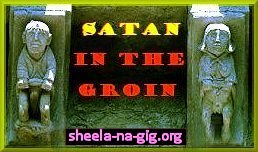A NOTE ON FRIEZES
These are strips of decoration which were a feature of Classical and earlier
sculpture.
The famous Parthenon Frieze is probably the best-known example.
On Romanesque churches they are almost always in false relief, and often set
amongst corbels.
Thus they tend to have the same sorts of subject.
Their most interesting antecedent, however, is the Coptic clavus,
or vertical strip of cloth deriving from the Roman laticlave,
a broad strip or band of purple on the front of the tunic, worn by senators
as an emblem of office.
Below is an example of a 4th-5th century Coptic clavus, shown horizontally.
It features a cross, a hare (sacred to Venus and later Christian symbols of
licentiousness),
a bull, a naked dancer, and a goat or stag - all to be found on Romanesque
friezes.

Coptic motifs (themselves emanating from the Middle East as well as the Mediterranean
basin)
were imported into (pre-Moorish) Visigothic art in Spain, and thence into
the Merovingian art of Northern France.
Somewhat later, they were again brought into Spain - by the Moors - and hence
indirectly to Southern France.
Click here for another Coptic weaving with relevance to Romanesque motifs and in particular the hare.
